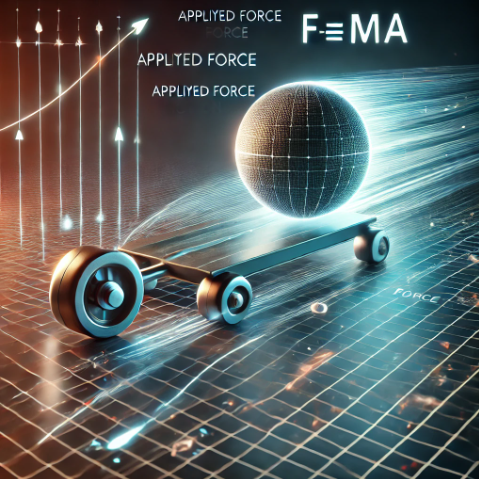2.6 Newton’s Second Law: Mastering the Net Force-Acceleration Relationship
Newton’s Second Law 🛫: The Fundamentals
Newton’s Second Law of Motion states:
“The acceleration of an object as produced by a net force is directly proportional to the magnitude of the net force, in the same direction as the net force, and inversely proportional to the mass of the object.”
Mathematically, this is represented as:
where:
- = Net force (N)
- = Mass of the object (kg)
- = Acceleration (m/s²)
Key Concepts
- Net Force: The vector sum of all forces acting on a particle or object.
- Mass: A measure of the amount of matter contained within an object, measured in kilograms (kg).
- Acceleration: The rate of change of an object’s velocity, measured in meters per second squared (m/s²).
Quick Points to Remember:
- Force (F) is measured in Newtons (N), where 1 N = 1 kg ⋅ m/s².
- The greater the mass of an object, the more force is needed to accelerate it.
- The greater the force applied, the higher the resulting acceleration.
- Newton’s Second Law helps explain everyday scenarios, such as why pushing a heavier object requires more force than pushing a lighter one.
Applying Newton’s Second Law in Real-Life Scenarios
Imagine pushing a car and a bicycle with the same amount of force. Due to its greater mass, the car will accelerate more slowly compared to the bicycle. This simple illustration shows how mass and force interact to produce different accelerations, all governed by Newton’s Second Law.
Using Free-Body Diagrams 🌐
Free-body diagrams are essential tools for visualizing all forces acting on a specific object, helping to understand and predict motion.
Steps to Create a Free-Body Diagram:
- Identify the Object: Focus on the object of interest.
- Sketch a Simple Representation: Depict the object as a dot, box, or any simplified shape.
- Identify Forces: Determine all external forces acting on the object (e.g., gravity, friction, tension).
- Draw Arrows: Represent each force with an arrow pointing in the direction of the force. The length of the arrow corresponds to the magnitude of the force.
- Label Each Force: Clearly mark each arrow (e.g., “gravity,” “friction,” “normal force”).
- Coordinate System (if needed): Add a coordinate system to help track force directions.
- Add Relevant Information: This may include mass, force values, or angles of applied forces.
Example Problem: Scale and Pulley System
Scenario: You stand on a scale attached to a pulley system. The scale has a mass of 75 kg, and you have a mass of 60 kg. A rope pulls the scale upward.
Step-by-Step Free-Body Diagram:
- Identify the Object: The scale is our primary object.
- Sketch: Draw a simple outline of the scale.
- Identify Forces:
- Gravity (Weight): Acts downward on both you and the scale.
- Normal Force: Acts upward, exerted by the scale.
- Tension Force: The force exerted by the rope pulling the scale upward.
- Draw Force Arrows:
- Downward arrow for gravity.
- Upward arrow for the normal force and tension force.
- Label the Forces.
- Optional Coordinate System.
- Include Masses and Values if needed.
Calculating Forces
Weight (Gravity):
For you (mass = 60 kg):Net Force: If the net force results in an upward motion, it means that the tension force exceeds the combined weight of you and the scale.
Practical Examples of Newton’s Second Law
- Pushing a Box: Applying a force to a box on a frictionless surface causes it to accelerate. The greater the force, the greater the acceleration.
- Rocket Launch: The thrust generated by the rocket engines produces a large force, causing it to accelerate upwards despite its massive weight.
Key Takeaways
- Newton’s Second Law explains how force, mass, and acceleration interact.
- Free-body diagrams simplify force analysis, crucial for solving physics problems.
- Net force determines whether an object accelerates or remains in equilibrium.
Frequently Asked Questions (FAQs)
Q: What is the relationship between mass and acceleration?
A: Mass is inversely proportional to acceleration. Higher mass means less acceleration for the same applied force.
Q: Why is a free-body diagram useful?
A: It helps visualize all forces acting on an object, aiding in force and motion calculations.







